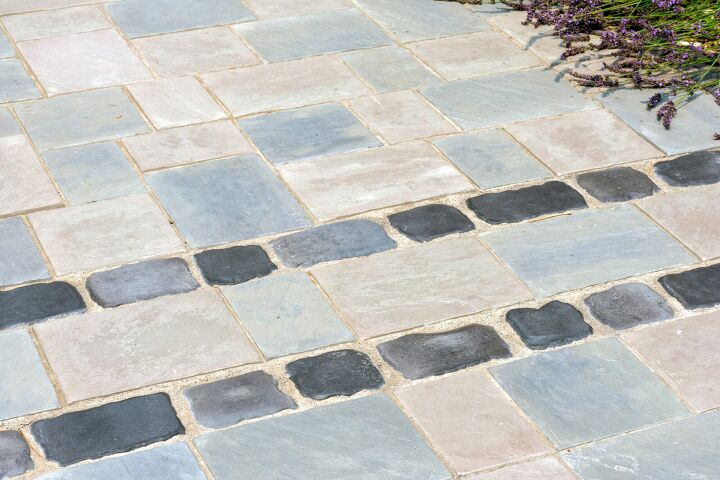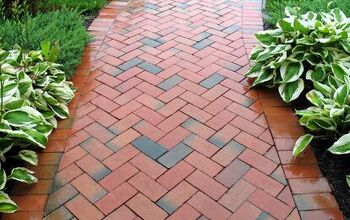Tumbled Pavers Vs. Non-Tumbled Pavers: Which One Is Better?

If you’re planning to update your patio, walkway, or driveway using natural stone, you have a number of options to choose from. Aside from choosing the size and color of the materials, you must also decide between tumbled pavers and non-tumbled pavers. Nowadays, many homeowners desire a more rustic, time-worn look out of their hardscape.
Fortunately, opting for tumbled pavers can give that old-world appearance you desire. Tumbled pavers retain much of the advantages of their non-tumbled counterparts, including ease of installation, durability, and affordability. However, they do tend to require slightly more maintenance and be a little more expensive because of the additional manufacturing process involved.
Before choose between tumbled pavers vs. non-tumbled pavers, it’s important that you understand the differences between these two types, along with the advantages they offer. That way, you can ensure that you make an informed decision regarding which type of paver is best for your installation purposes.
Do You Need Pavers for Driveway and Floors Installed?
Get free, zero-commitment quotes from pro contractors near you.

What is a Tumbled Stone Paver?
Tumbled pavers receive their name from their manufacturing process. During the tumbling process, stone pavers are placed in a plastic or rubber-coated metal barrel, along with water and abrasive grit. This machine turns nonstop at a consistent pace for about three to five weeks depending on the desired finish.
While inside the barrel, the pavers grind against each other, resulting in a more classic, “Old World” appearance. The texture on all six sides of the tumbled stone pavers is smooth and soft. Then, during the paving process, sealant and grout is applied to tumbled stones to remove the conventional dusty look and enhance the natural colors, grains, and veins found in the stone.
Benefits of Tumbled Stone Pavers
Both tumbled pavers and non-tumbled pavers come with their own advantages. With tumbled pavers being the most popular option of the two, here are some of the benefits that homeowners are enjoying:
- Anti-skid surfaces. During the tumbling process, the natural pores of the stone surfaces are exposed. Ultimately, tumbled pavers end up with coarse surfaces, instead of the traditional polished, glazed finish. This feature reduces the risk of slips in wet conditions, providing an anti-skid surface for areas that see more moisture than others.
- Suitable for a variety of applications. The non-slip surface that tumbled pavers provide makes them suitable for everything from swimming pool decks and pool coping, to tub surrounds, walk-in showers, and more. They also allow safe foot trafficking on walkways and pathways around your property.
- Classic, rustic, old-world look. Nowadays, most property owners want more of a rustic, weathered appearance for their hardscapes. Laying patios, plazas, pool decks, walkways, and even driveways with tumbled pavers create a characteristic sense of elegance and permeance. They are fresh pavers that give a decades old look, allowing you to enjoy the time-worn aesthetic you want with a much longer lifespan.
- Enhanced property value. The look of tumbled pavers yields a very unique visual appeal that is highly desired in the stone industry. Due to the high-quality nature of tumbled stone paving, they can actually raise your property value.
- Weatherproof material. Tumbled stone pavers will not only save your feet from burning in the summer, but they will also remain intact during the freeze and thaw cycles of winter. Since tumbled stones are porous, they pass both water and humidity effortlessly, meaning that rainy or humid climates will have little effect on your tumbled stone paving.
- Easy to install and maintain. Many tumbled paver manufacturers offer ready-to-use kits, catering to DIYers. In regards to maintenance, thanks to sealants and polymeric sand, your tumbled pavers are virtually impervious to liquids. Spills have a tough time remaining on the surface and although the gaps between stones are wider, the polymeric sand makes the grouts watertight.
How Does Tumbling Impact Paver Installation Costs?
The main difference between tumbled pavers and non-tumbled pavers is the additional process during manufacturing that tumbled pavers must go through. Traditionally, pavers were tumbled in a large drum – similar to those you see on the back of a cement truck. Over a period of time, the pavers are turned slowly, sorted, and then stacked for delivery.
This process is incredibly time-consuming, adding anywhere from .50 to .75 cents per square foot to the cost of materials. Nowadays, in-line tumblers are more commonly used in manufacturing plants, which makes tumbling a more streamlined process. The second factor that influences cost is installation.
Since tumbled pavers involve wider, more irregular joints, a joint sand stabilizer must be applied. In most cases, this is done using polymeric sand, which features polymer binding agents that lock the pavers into place. The addition of polymeric sand in the installation process can add up to .80 per square foot to your paver project.
Paver Maintenance Considerations
With conventional un-tumbled pavers, the joints are so small that the paver sand stays put and requires very minimal maintenance except for an occasional cleaning and refresh every couple years. Whereas, with tumbled pavers, the joints and corners are wider, which gives the polymeric sand an almost grout-like appearance.
Over time, the polymeric sand will deteriorate and eventually need replacing. The voids in the joints can also allow weeds to grow or insects and ants to congregate. Not to mention, since polymeric sand doesn’t permit water to pass through the paver joints, they will develop mold or mildew much easier.
When to Use Tumbled Pavers
Tumbled pavers tend to be the most popular choice for exterior renovation projects. These stones, which are roughly 1.25 inches thick, are somewhat porous, which allows them to absorb moisture quickly. For this reason, tumbled pavers are ideal for use on poolside patios, pathways, and any other applications that will experience a lot of foot traffic.
Although a large majority of tumbled paver products are ADA compliant, they do have a much rougher, less even surface texture. This must be considered if you plan to roll anything over the surface, such as a skateboard or wheelchair. Though, their coarse texture makes for a virtually non-slip environment in areas with high foot traffic.
Additionally, tumbled pavers stand up exceptionally well during the freeze and thaw cycle of winter, making them an excellent choice for those who live in a colder climate. Overall, these pavers blend wonderfully into most residential and commercial applications, satisfying the growing desire for natural surfaces.
When to Use Non-Tumbled Pavers
Non-tumbled pavers, on the other hand, come with their own unique set of advantages. These stones are outfitted with a honed surface that helps limit the absorption of liquids. This feature is especially beneficial for oil spills, making non-tumbled pavers a good choice for driveway projects. By reducing the likelihood of oil or other liquids absorbing into the material, non-tumbled pavers help avoid potentially permanent staining.
On the downside, the lack of absorption that these stones have can make them slippery when they get wet. As such, they are not recommended for poolside areas, garden pathways, or any other locations that experience higher levels of moisture. Another advantage to opting for non-tumbled pavers is their carved edges, which deliver traction to vehicle wheels to prevent slipping when the surface is wet.
Do You Need Pavers for Driveway and Floors Installed?
Get free, zero-commitment quotes from pro contractors near you.

Tumbled Pavers vs. Non-Tumbled Pavers
The type of paver that you use is often determined based on the specific outdoor renovation project that you’re trying to achieve. If you’re planning to build a walkway or patio that will see a lot of foot traffic, your best option is to go with tumbled pavers. They will provide a safer, less slippery surface. Whereas, non-tumbled pavers are ideal for driveways, as they prevent oil stains and provide better traction for wheels.
In terms of appearance, the finishing process involved in tumbled pavers gives a highly desirable old-world, time-worn look. Despite being slightly more expensive and requiring a little more maintenance than non-tumbled pavers, opting for tumbled pavers can deliver a unique aesthetic appeal to your home, potentially increasing the property value.
Related Guides

Jessica considers herself a home improvement and design enthusiast. She grew up surrounded by constant home improvement projects and owes most of what she knows to helping her dad renovate her childhood home. Being a Los Angeles resident, Jessica spends a lot of her time looking for her next DIY project and sharing her love for home design.
More by Jessica Stone



























